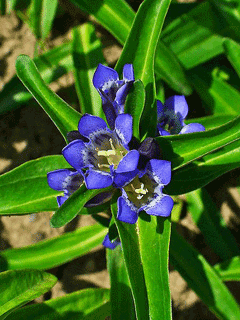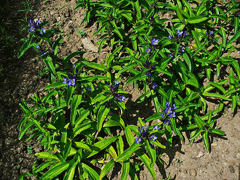 |
|
http://commons.wikimedia.org/wiki/User:Llez |
 |
| http://commons.wikimedia.org/wiki/User:Llez |
Translate this page:
Summary
Physical Characteristics

 Gentiana cruciata is a PERENNIAL growing to 0.4 m (1ft 4in). It is in flower from July to October. The species is hermaphrodite (has both male and female organs) and is pollinated by Bumblebees, butterflies.
Gentiana cruciata is a PERENNIAL growing to 0.4 m (1ft 4in). It is in flower from July to October. The species is hermaphrodite (has both male and female organs) and is pollinated by Bumblebees, butterflies.
Suitable for: light (sandy), medium (loamy) and heavy (clay) soils and prefers well-drained soil. Suitable pH: mildly acid, neutral and basic (mildly alkaline) soils. It can grow in semi-shade (light woodland) or no shade. It prefers moist soil.
UK Hardiness Map
US Hardiness Map
Synonyms
Plant Habitats
Woodland Garden Sunny Edge; Cultivated Beds;
Edible Uses
The root is sometimes used in the manufacture of gentian bitters[183].
References More on Edible Uses
Medicinal Uses
Plants For A Future can not take any responsibility for any adverse effects from the use of plants. Always seek advice from a professional before using a plant medicinally.
Appetizer Bitter Digestive Febrifuge Stomachic Tonic
The root is appetizer, bitter tonic, digestive, febrifuge and stomachic[61, 100]. It is used in the treatment of hoarseness and sore throats[4]. The root is a possible substitute for gentian root[4], though the report is not clear enough on this point[K]. Listed below are the uses of G. lutea, the most widely used gentian root. Gentian root has a long history of use as a herbal bitter in the treatment of digestive disorders and is an ingredient of many proprietary medicines. It contains some of the most bitter compounds known and is used as a scientific basis for measuring bitterness[238]. It is especially useful in states of exhaustion from chronic disease and in all cases of debility, weakness of the digestive system and lack of appetite[4]. It is one of the best strengtheners of the human system, stimulating the liver, gall bladder and digestive system[238], and is an excellent tonic to combine with a purgative in order to prevent its debilitating effects[4]. The root is anthelmintic, anti-inflammatory, antiseptic, bitter tonic, cholagogue, emmenagogue, febrifuge, refrigerant, stomachic[4, 7, 9, 14, 21, 165, 238]. It is taken internally in the treatment of liver complaints, indigestion, gastric infections and anorexia[238]. It should not be prescribed for patients with gastric or duodenal ulcers[238]. The root is harvested in the autumn and dried for later use[4]. It is quite likely that the roots of plants that have not flowered are the richest in medicinal properties[4].
References More on Medicinal Uses
The Bookshop: Edible Plant Books
Our Latest books on Perennial Plants For Food Forests and Permaculture Gardens in paperback or digital formats.

Edible Tropical Plants
Food Forest Plants for Hotter Conditions: 250+ Plants For Tropical Food Forests & Permaculture Gardens.
More

Edible Temperate Plants
Plants for Your Food Forest: 500 Plants for Temperate Food Forests & Permaculture Gardens.
More

More Books
PFAF have eight books available in paperback and digital formats. Browse the shop for more information.
Shop Now
Other Uses
References More on Other Uses
Cultivation details
In general, gentians require a moist well-drained soil in a sheltered position, a certain minimum of atmospheric humidity, high light intensity but a site where temperatures are not too high[239]. They are therefore more difficult to grow in areas with hot summers and in such a region they appreciate some protection from the strongest sunlight[200, 239]. Most species will grow well in the rock garden[200]. This species is easily grown in any good garden soil[187], preferring drier conditions than most other members of the genus[239]. Plants are hardy to at least -20°c[187]. A moisture loving plant, preferring to grow with full exposure to the sun but with plenty of underground moisture in the summer, it grows better in the north and west of Britain[1]. Plants are intolerant of root disturbance[200].
References Carbon Farming Information and Carbon Sequestration Information
Temperature Converter
Type a value in the Celsius field to convert the value to Fahrenheit:
Fahrenheit:
The PFAF Bookshop
Plants For A Future have a number of books available in paperback and digital form. Book titles include Edible Plants, Edible Perennials, Edible Trees,Edible Shrubs, Woodland Gardening, and Temperate Food Forest Plants. Our new book is Food Forest Plants For Hotter Conditions (Tropical and Sub-Tropical).
Shop Now
Plant Propagation
Seed - best sown as soon as it is ripe in a light position in a cold frame[200]. It can also be sown in late winter or early spring but the seed germinates best if given a period of cold stratification and quickly loses viability when stored, with older seed germinating slowly and erratically[200, 239]. It is advantageous to keep the seed at about 10°c for a few days after sowing, to enable the seed to imbibe moisture[239]. Following this with a period of at least 5 - 6 weeks with temperatures falling to between 0 and -5°c will usually produce reasonable germination[239]. It is best to use clay pots, since plastic ones do not drain so freely and the moister conditions encourage the growth of moss, which will prevent germination of the seed[239]. The seed should be surface-sown, or only covered with a very light dressing of compost. The seed requires dark for germination, so the pots should be covered with something like newspaper or be kept in the dark[239]. Pot up the seedlings into individual pots as soon as they are large enough to handle and grow on in light shade in the greenhouse for at least their first winter. The seedlings grow on very slowly, taking 2 - 7 years to reach flowering size[239]. When the plants are of sufficient size, place them out into their permanent positions in late spring or early summer. Division in March[111, 239]. Cuttings of basal shoots in late spring[238].
Other Names
If available other names are mentioned here
Native Range
TEMPERATE ASIA: Iran (northwest), Turkey, Russian Federation-Ciscaucasia (Ciscaucasia), Armenia, Azerbaijan, Georgia, Russian Federation (Dagestan), Russian Federation (Kurganskaja oblast, Novosibirsk, Omsk, Tyumen (south)), Kazakhstan EUROPE: Austria, Belgium, Switzerland, Czech Republic, Germany, Hungary, Netherlands, Poland, Slovakia, Russian Federation (European part), Belarus, Estonia, Lithuania, Latvia, Moldova, Ukraine (incl. Krym), Albania, Bulgaria, Greece, Croatia, Italy, Romania, Serbia, Slovenia, Spain, France
Weed Potential
Right plant wrong place. We are currently updating this section.
Please note that a plant may be invasive in one area but may not in your area so it's worth checking.
Conservation Status
IUCN Red List of Threatened Plants Status :

Growth: S = slow M = medium F = fast. Soil: L = light (sandy) M = medium H = heavy (clay). pH: A = acid N = neutral B = basic (alkaline). Shade: F = full shade S = semi-shade N = no shade. Moisture: D = dry M = Moist We = wet Wa = water.
Now available:
Food Forest Plants for Mediterranean Conditions
350+ Perennial Plants For Mediterranean and Drier Food Forests and Permaculture Gardens.
[Paperback and eBook]
This is the third in Plants For A Future's series of plant guides for food forests tailored to
specific climate zones. Following volumes on temperate and tropical ecosystems, this book focuses
on species suited to Mediterranean conditions—regions with hot, dry summers and cool, wet winters,
often facing the added challenge of climate change.
Read More
Expert comment
Author
L.
Botanical References
50200
Links / References
For a list of references used on this page please go here
Readers comment
© 2010, Plants For A Future. Plants For A Future is a charitable company limited by guarantee, registered in England and Wales. Charity No. 1057719, Company No. 3204567.